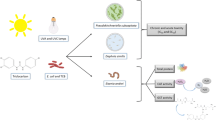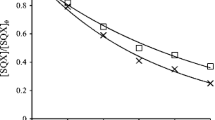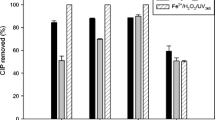Abstract
In the present study, in vitro toxicity as well as biopersistence and photopersistence of four artificial sweeteners (acesulfame, cyclamate, saccharine, and sucralose) and five antibiotics (levofloxacin, lincomycin, linezolid, marbofloxacin, and sarafloxacin) and of their phototransformation products (PTPs) were investigated. Furthermore, antibiotic activity was evaluated after UV irradiation and after exposure to inocula of a sewage treatment plant. The study reveals that most of the tested compounds and their PTPs were neither readily nor inherently biodegradable in the Organisation for Economic Co-operation and Development (OECD)-biodegradability tests. The study further demonstrates that PTPs are formed upon irradiation with an Hg lamp (UV light) and, to a lesser extent, upon irradiation with a Xe lamp (mimics sunlight). Comparing the nonirradiated with the corresponding irradiated solutions, a higher chronic toxicity against bacteria was found for the irradiated solutions of linezolid. Neither cytotoxicity nor genotoxicity was found in human cervical (HeLa) and liver (Hep-G2) cells for any of the investigated compounds or their PTPs. Antimicrobial activity of the tested fluoroquinolones was reduced after UV treatment, but it was not reduced after a 28-day exposure to inocula of a sewage treatment plant. This comparative study shows that PTPs can be formed as a result of UV treatment. The study further demonstrated that UV irradiation can be effective in reducing the antimicrobial activity of antibiotics, and consequently may help to reduce antimicrobial resistance in wastewaters. Nevertheless, the study also highlights that some PTPs may exhibit a higher ecotoxicity than the respective parent compounds. Consequently, UV treatment does not transform all micropollutants into harmless compounds and may not be a large-scale effluent treatment option.







Similar content being viewed by others
References
Agrawal H, Mahadik KR, Paradkar AR, Kaul N (2003) Stability indicating HPTLC determination of linezolid as bulk drug and in pharmaceutical dosage form. Drug Dev Ind Pharm 29:1119–1126
Bergheim M, Gieré R, Kümmerer K (2012) Biodegradability and ecotoxicitiy of tramadol, ranitidine, and their photoderivatives in the aquatic environment. Env Sci Pol Res 19:72–85
Bergheim M, Gminski R, Spangenberg B, Debiak M, Bürkle A, Mersch-Sundermann V, Kümmerer K, Gieré R (2014) Recalcitrant pharmaceuticals in the aquatic environment: a comparative screening study on their occurrence, formation of phototransformation products and their in-vitro toxicity. Environ Chem 11:431–444
Buerge IJ, Buser HR, Kahle M, Muller MD, Poiger (2009) Ubiquitous occurrence of the artificial sweetener acesulfame in the aquatic environment: an ideal chemical marker of domestic wastewater in groundwater. Environ Sci Technol 43:4381–4385
Calamari D, Zuccato E, Castiglioni S, Bagnati R, Fanelli R (2003) Strategic survey of therapeutic drugs in the rivers Po and Lambro in northern Italy. Environ Sci Technol 37:1241–1248
Castiglioni S, Fanelli R, Calamari D, Bagnati R, Zuccato E (2004) Methodological approaches for studying pharmaceuticals in the environment by comparing predicted and measured concentrations in River Po, Italy. Regul Toxicol Pharm 39:25–32
Coiffard CAC, Coiffard LJM, de Roeck-Holtzhauer YMR (1999) Photodegradation kinetics of acesulfame-K solutions under UV light: effect of pH. Z Lebensm Unters Forsch A 208:6–9
Debiak M, Panas A, Steinritz D, Kehe K, Bürkle A (2011) Highthroughput analysis of DNA interstrand crosslinks in human peripheral blood mononuclear cells by automated reverse FADU assay. Toxicology 280:53–60
Fasani E, Tilocca F, Protti S, Merli D, Albini A (2008) An exploratory and mechanistic study of the defluorination of an (aminofluorophenyl)oxazolidone: SN1(Ar*) vs. SR+N1(Ar*) mechanism. Org Biomol Chem 6:4634–4642
Fatta-Kassinos D, Vasquez MI, Kümmerer K (2011) Transformation products of pharmaceuticals in surface waters and wastewater formed during photolysis and advanced oxidation processes - Degradation, elucidation of byproducts and assessment of their biological potency. Chemosphere 85:693–709
Garcia-Käufer M, Haddad T, Bergheim M, Gminski R, Gupta P, Mathur N, Kümmerer K, Mersch-Sundermann V (2012) Genotoxic effect of ciprofloxacin during photolytic decomposition monitored by the in vitro micronucleus test (MNvit) in HepG2 cells. Environ Sci Pollut Res 19:1719–1727
Ge L, Chen J, Wei X, Zhang S, Qiao X, Cai X, Xie Q (2010) Aquatic photochemistry of fluoroquinolone antibiotics: kinetics, pathways, and multivariate effects of main water constituents. Environ Sci Technol 44:2400–2405
Grice HC, Goldsmith LA (2000) Sucralose - an overview of the toxicity data. Food Chem Toxicol 38:S1–S6
Hjorth M, Hansen JH, Camus L (2010) Short-term effects of sucarlose on Calanus finmarchicus and Calanus glacialis in Disko Bay, Greenland. Chem Ecol 26:385–393
Huggett DB, Stoddard KI (2011) Effects of the artificial sweetener sucralose on Daphnia magna and Americamysis bahia survival, growth and reproduction. Food Chem Toxicol 49:2575–2579
Jia A, Wan Y, Xiao Y, Hu JY (2012) Occurrence and fate of quinolone and fluoroquinolone antibiotics in a municipal sewage treatment plant. Water Res 46:387–394
Kemper N (2008) Veterinary antibiotics in the aquatic and terrestrial Environment. Ecol Indic 8:1–13
Khetan SK, Collins TJ (2007) Human pharmaceuticals in the aquatic environment: a challenge to green chemistry. Chem Rev 107:2319–2364
Kim J-W, Jan H-S, Kim J-G, Ishibashi H, Hirano M, Nasu K, Ichikawa N, Takao Y, Shinohara R, Arizono K (2009) Occurence of pharmaceutical and personal care products (PPCPs) in surface water from Mankyung River, South Korea. J Health Sci 55:249–258
Kolpin DW, Furlong ET, Meyer MT, Thurman EM, Zaugg SD, Barber LB, Buxton HT (2002) Pharmaceuticals, hormones, and other organic wastewater contaminants in US streams, 1999–2000: a national reconnaissance. Environ Sci Technol 36:1202–1211
Kümmerer K (2009) Antibiotics in the environment – a review – part II. Chemosphere 75:417–434
Li B, Zhang T (2010) Biodegradation and adsorption of antibiotics in the activated sludge process. Environ Sci Technol 44:3468–3473
Lin AYC, Yu TH, Lin CF (2008) Pharmaceutical contamination in residential, industrial, and agricultural waste streams: risk to aqueous environments in Taiwan. Chemosphere 74:131–141
Lubick N (2008) Artificial sweetener persists in the environment. Environ Sci Technol 42:3125
Marchese A, Schito GC (2001) The oxazolidinones as a new family of antimicrobial agent. Clin Microbiol Infect 7:66–74
Mawhinney DB, Young RB, Vanderford BJ, Borch T, Snyder SA (2011) Artificial sweetener sucralose in U.S. drinking water systems. Environ Sci Technol 45:8716–8722
Mead RN, Morgan JB, Avery GB, Kieber RJ, Kirk AM, Skrabal SA, Willey JD (2009) Occurrence of the artificial sweetener sucralose in coastal and marine waters of the United States. Mar Chem 116:13–17
Michael I, Rizzo L, McArdell CS, Manaia CM, Merlin C, Schwartz T, Dagot T, Fatta-Kassinos D (2013) Urban wastewater treatment plants as hotspots for the release of antibiotics in the environment: a review. Water Res 47:957–995
Moreno-Villanueva M, Pfeiffer R, Sindlinger T, Leake A, Müller M, Kirkwood T B, Bü̈rkle A (2009) A modified and automated version of the ‘fluorimetric detection of alkaline DNA unwinding’ method to quantify formation and repair of DNA strand breaks. BMC Biotechnol 9:1–9
Oppenheimer JA, Badruzzaman M, Jacangelo JG (2012) Differentiating sources of anthropogenic loading to impaired water bodies utilizing ratios of sucralose and other microconstituents. Water Res 46:5904–5916
Prabhakaran D, Sukul P, Lamshoft M, Maheswari MA, Zuhlke S, Spiteller M (2009) Photolysis of difloxacin and sarafloxacin in aqueous systems. Chemosphere 77:739–746
Püttmann W, Keil F, Oehlmann J, Schulte-Oehlmann U (2008) Wassertechnische Strategien zur Reduzierung der Trinkwasserbelastung durch Arzneimittelwirkstoffe. Umweltwissenschaften Schadstoff-Forschung 20:209–226
Rodero AB, Rodero LS, Azoubel R (2009) Toxicity of sucralose in humans: a review. Int J Morphol 27:239–244. URL:www.scielo.cl/pdf/ijmorphol/v27n1/art40.pdf
Scheurer M, Brauch HJ, Lange FT (2009) Analysis and occurrence of seven artificial sweeteners in German waste water and surface water and in soil aquifer treatment (SAT). Anal Bioanal Chem 394:1585–1594
Seigel A, Schroeck A, Hauser R, Spangenberg B (2011) Sensitive quantification of diclofenac and ibuprofen using thin layer chromatography coupled with A vibrio fisheri bioluminescence assay. J Liq Chrom Relat Tech 34:817–828
Soh, Connors KA, Brooks BW, Zimmerman J (2011) Fate of sucralose through environmental and water treatment processes and impact on plant indicator species. Environ Sci Technol 45:1363–1369
Sturini M, Speltini A, Maraschi F, Profumo A, Pretali L, Fasani E, Albini A (2012) Sunlight-induced degradation of soil-adsorbed veterinary antimicrobials Marbofloxacin and Enrofloxacin. Chemosphere 86:130–137
Sturini M, Speltin A, Pretali L, Fasani E, Profumo A (2009) Solid-phase ectraction and HPLC determination of fluoroquinolones in suface waters. J Sep Sci 32:2020–3028
Sukul P, Spiteller M (2007) Fluoroquinolone antibiotics in the environment. Rev Environ Contam Toxicol 191:131–162
Van Stempvoort DR, Roy JW, Brown SJ, Bickerton G (2011) Artificial sweeteners as potential tracers in groundwater in urban environments. J Hydrol 401:126–133
Watkinson A, Murby E, Costanzo S (2007) Removal of antibiotics in conventional and advanced wastewater treatment: implications for environmental discharge and wastewater recycling. Water Res 41:4164–4176
Weihrauch MR, Diehl V (2004) Artificial sweeteners - do they bear a carcinogenic risk? Ann Oncol 15:1460–1465
Wiklund AKE, Breitholtz M, Bengtsson BE, Dolfsson-Erici M (2012) Sucralose - an ecotoxicological challenger? Chemosphere 86:50–55
Yan S, Song W (2014) Photo-transformation of pharmaceutically active compounds in the aqueous environment: a review. Environ Sci Process Impacts 16:697–720
Acknowledgments
Marlies Bergheim wishes to thank the German Environment Foundation (DBU), Stiftung Viamedica (Director: Prof. Daschner), the Frankfurter Allgemeine Zeitung (FAZ), and the Vereinte Studienstiftung of the University of Freiburg for providing financial support through scholarships. We are grateful to two anonymous reviewers whose comments and suggestions helped improving this paper.
Author information
Authors and Affiliations
Corresponding author
Additional information
Responsible editor: Roland Kallenborn
Electronic supplementary material
Below is the link to the electronic supplementary material.
Fig. 1S
Total ion chromatograms (TICs), extracted ion chromatograms (EICs) (m/z 338, m/z 267, m/z 289, m/z 294, m/z 316, m/z 372, m/z 350) and UV spectra (275 nm) of linezolid from test samples at 0 min, 4 min and 128 min irradiation with a Hg lamp (left) and a Xe lamp (right) (PPT 536 kb)
Rights and permissions
About this article
Cite this article
Bergheim, M., Gminski, R., Spangenberg, B. et al. Antibiotics and sweeteners in the aquatic environment: biodegradability, formation of phototransformation products, and in vitro toxicity. Environ Sci Pollut Res 22, 18017–18030 (2015). https://doi.org/10.1007/s11356-015-4831-x
Received:
Accepted:
Published:
Issue Date:
DOI: https://doi.org/10.1007/s11356-015-4831-x




